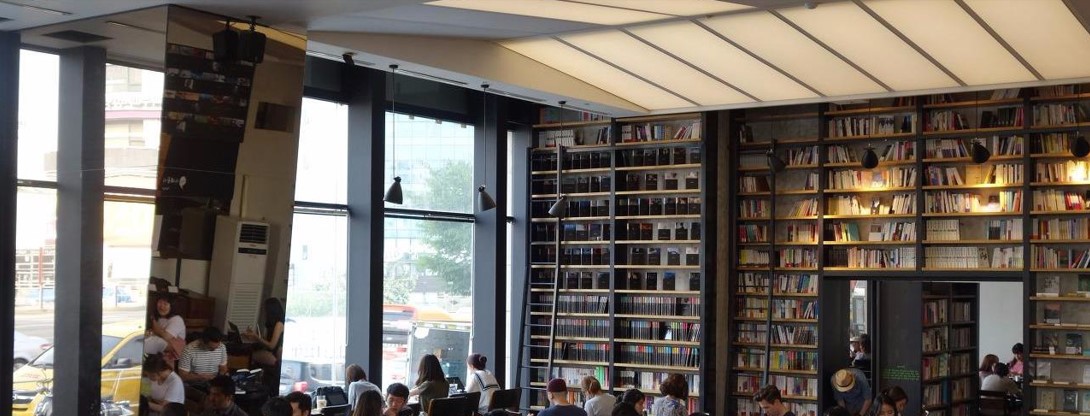Phenomenon 1. Becoming the Purpose of the Visit
Phenomenon 2. Connecting Residents and Communities
Phenomenon 3. Weaving an Experience
Cafes have now become deeply engrained in our daily lives. Amid the increasing number of cafes that focus on experiences, both in the city centre and on the outskirts, there are others that quietly play a role in the provincial neighbourhoods by strengthening their regional ties. One can visit for a brief chit-chat after a walk around the neighbourhood, sometimes lingering for a longer period of time to read a book. On other days, it transforms into a flea market, while in the evenings public reading sessions are held. What role should a cafe play in places rich with community life as opposed to in those of extraordinary urban contexts? This interview with Yeom Hyeonsook (principal, Cafe Comma) and Yim Taebyoung (principal, mundohoje) takes a look at cafes in the city that think about their surrounding communities. Both are experienced in the planning of cafes—Yeom has over 10 years of experience in planning and operating a book cafe, while Yim planned the first floor cafes of Harvest Mansion and Rainbow Inn.
Interview Yeom Hyeonsook principal, Café Comma x Kim Jia
Not a Library nor a Bookshop, but a Book Café: Café Comma
Kim Jia (Kim): Café Comma opened in 2011 with its first store in Seogyo-dong overseen by a publishing company, the Munhakdongne Publishing Group. How did you come up with the idea of opening a book café?
Yeom Hyeonsook (Yeom): Books have infinite possibilities. A book can open up a new pathway to experiencing a different time and space. Although there are now different routes to accessing books, including internet bookstores, books still seem to be moving further away from occupying a place in people’s lives. Pondering ways for people to gain easier access to books, there seemed to be nothing better than a café. That’s how we came up with Café Comma in the parking lots of Hongdae area.
Kim: In early 2010’s, a number of publishing companies in the Hongdae area launched book cafés to extend their contact with readers. Café Comma is the only place that has survived and continuously operating until now. What do you think made the difference?
Yeom: While most publishers use their office building for book cafés, Café Comma offered a separate space. There was no grand plan to start with, however we had an exact concept that we wanted to see materialise—to create a cosy space surrounded by 15-tier high bookshelves. The high bookshelves, which are now the signal identity of Café Comma, were inspired by an interview of Junot Díaz, a Pulitzer Prize winning writer. His comment, ‘The memory of standing in front of huge bookshelves made me a journalist’, deeply moved us, and we wanted to create a space in which one could be surrounded by books. It is difficult to experience the sentiments of being surrounded by books in daily life other than being at the library or a bookstore. In addition, the books at Café Comma do not only function as part of the interior, but also as an experiential programme where visitors may come to read, attracting those who seek to read and work in a comfortable atmosphere.
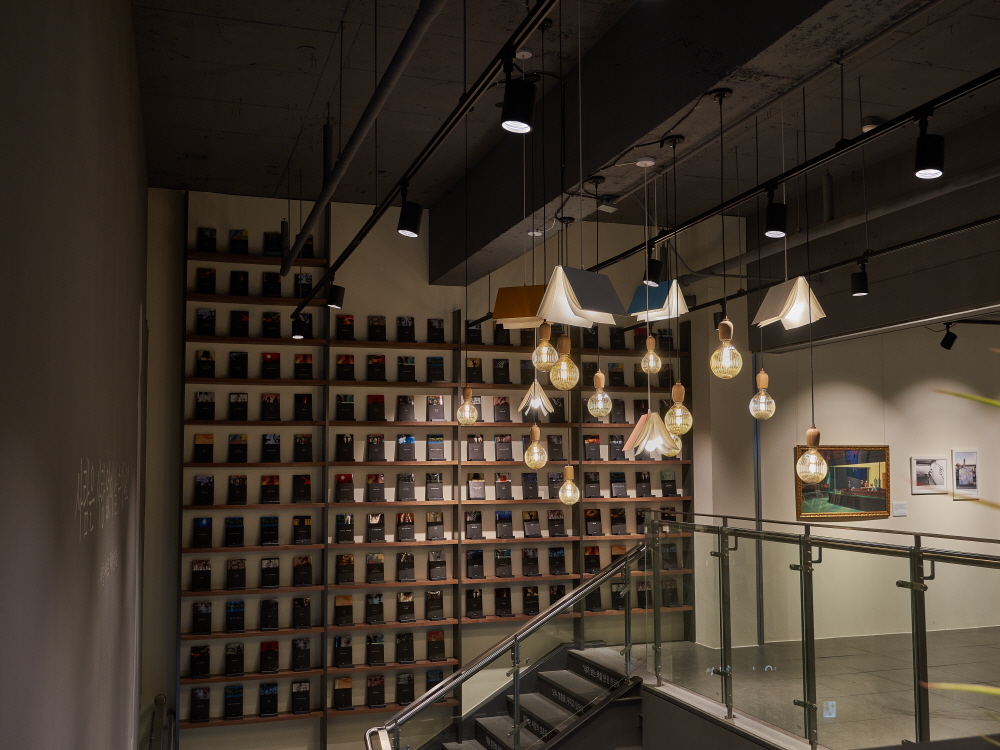
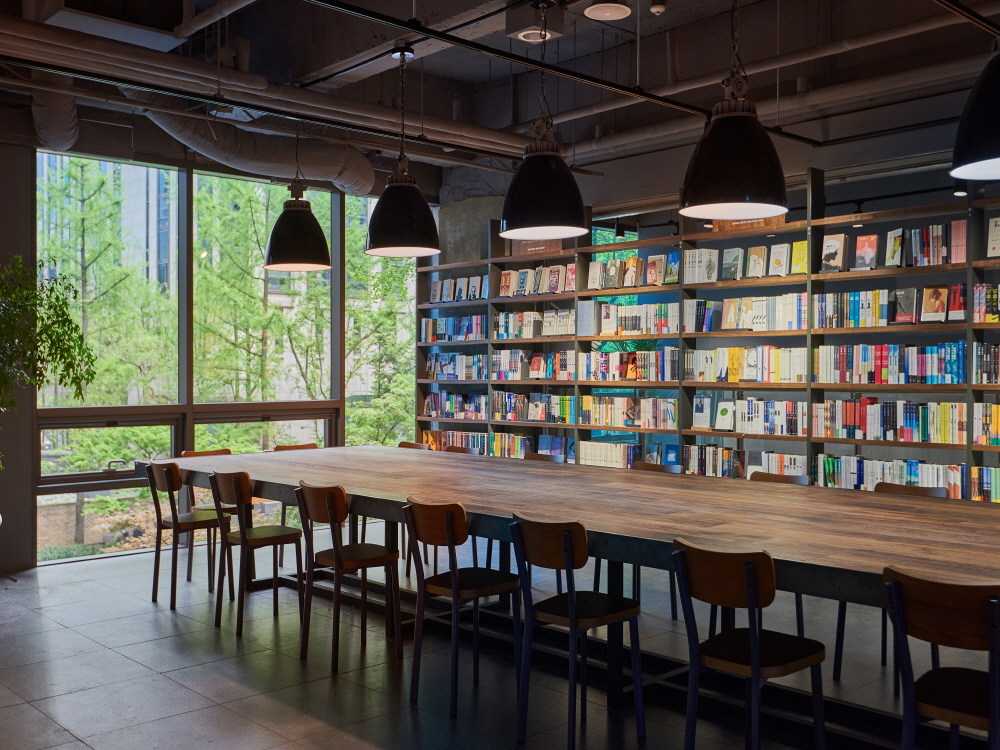 Café Comma Yeouido
Café Comma Yeouido
Kim: A book café is a space primarily focused on books, but is also a space in which people come to stay. What are some important thought points that you considered in creating the space?
Yeom: Thanks to the success of the first branch, the second branch opened in Donggyo-dong supplementing various elements through an initial process of trial and error. In addition to high bookshelves, there were other points to consider when creating a place in which people would to linger. While the first Café Comma had a high ceiling height and a comparatively small space of 99 – 132㎡, the second store presented a large open space of approximately 297㎡. In creating this area we referenced the salon culture in European countries, which tend to have the spatial characteristics of large windows and terrace space. The initial thoughts behind Café Comma were to place bookshelves in the streets, and therefore openness is an essential element. We sometimes displayed refurbished books in the terrace so that people can come browse the books on their strolls. As for the interiors, we used bookshelves to create hallways and separate areas for conversations and those to read books. In addition, we designed a stand-type stair for various cultrual events such as lectures and talk shows related to books. In fact, various events have been held with the participation of different domestic to international artists such as Han Kang, Kim Youngha, J.M.G. Le Clézio, and Oe Kenzaburo.
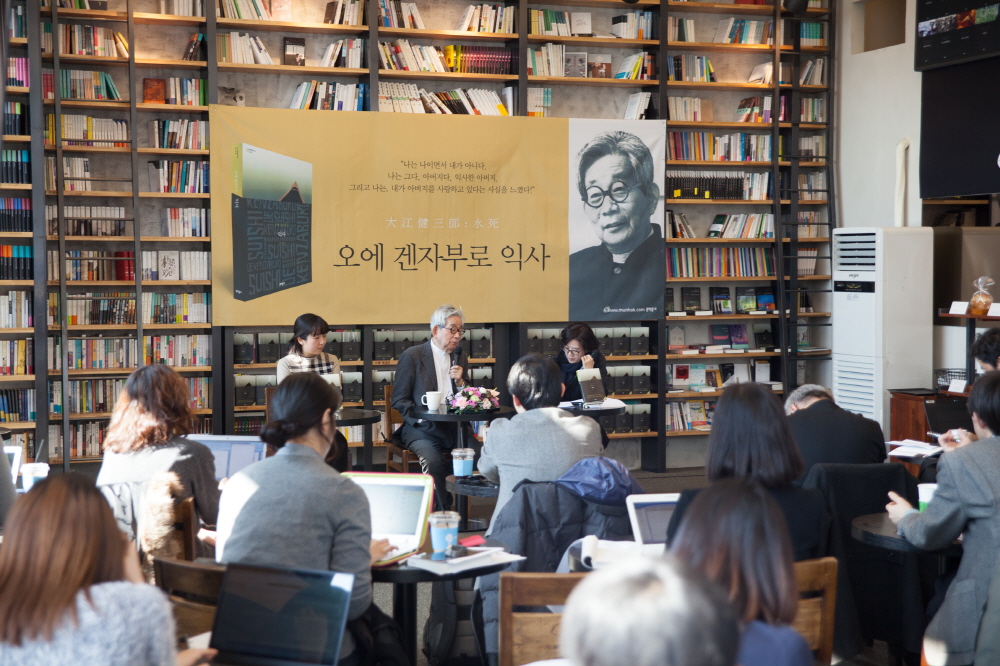 Press conference for the publication of Kenzaburo Oe's novel held at Cafe Comma page 2
Press conference for the publication of Kenzaburo Oe's novel held at Cafe Comma page 2
Kim: Café Comma started out as a book café and is now expanding into a cultural complex space in the city with books, coffee, and bread. What was the trigger for this diversification?
Yeom: We came to the conclusion when the rent prices became more and more difficult to afford around the year 2017, with the gentrification of the Hongdae area where first and second stores are located. Therefore, after closing the two branches that had been so long beloved by local residents and which had established Café Comma’s identity as more than a café, it became critical to find a solution to the situation. At this point, there were some who identified the potential of Café Comma and suggested the opening of a new branch in their buildings. Café Comma in Songdo, located within the IBS Tower, is one of the branches created in the process. This third branch situates itself in a totally different context compared to its precedents. It is located in a commercial district dominated by office buildings, and the proposed conditions were the lobby spaces of the IBS Tower. With the different contexts, the conditions may seem vague, however from different perspectives this meant that the area was a void, and was in need of cultural infrastructure such as Café Comma. The area also had residential buildings such as apartment complexes, and the spacious lobby area of approximately 2250㎡ had room for diverse spatial compositions. Not only was it possible to revel in the bookshelves reaching to the ceiling, but it was also possible to create a slightly different atmosphere by introducing variation in each area. Although the building had a high vacancy rate, the café attracted users and is now still actively operating. Office workers are the main visitors on weekdays, and families on weekends. With the success of the Songdo branch, we began to search for ways to expand while still maintaining the basics of a book café, and in the process we incorporated Café Comma and became independent from the Munhakdongne Publishing Group.
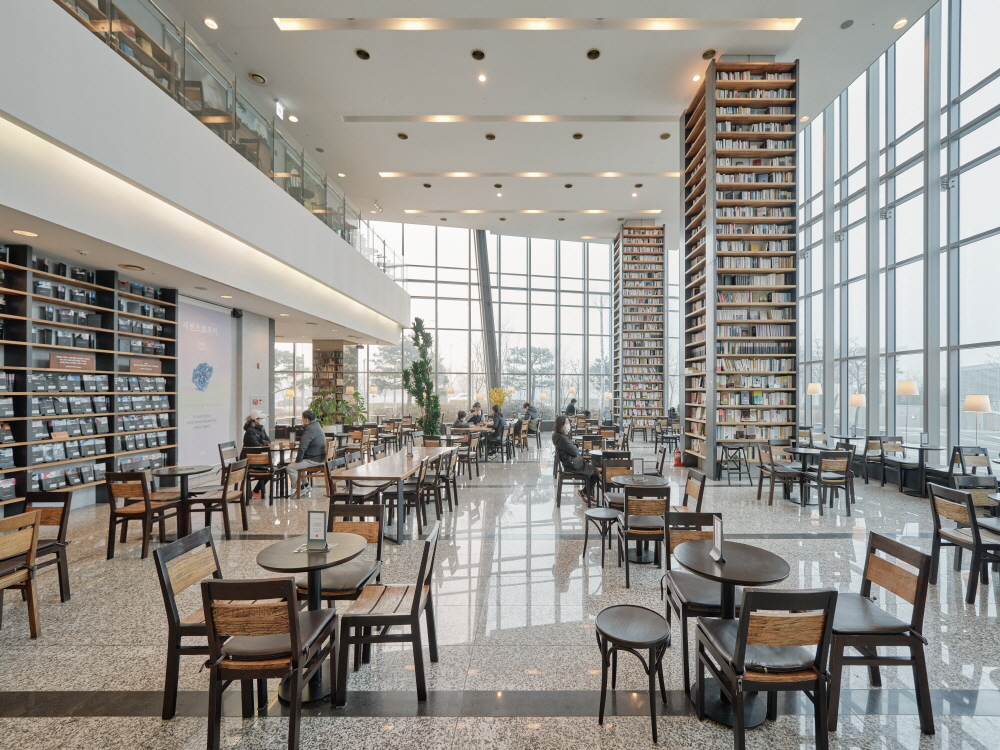
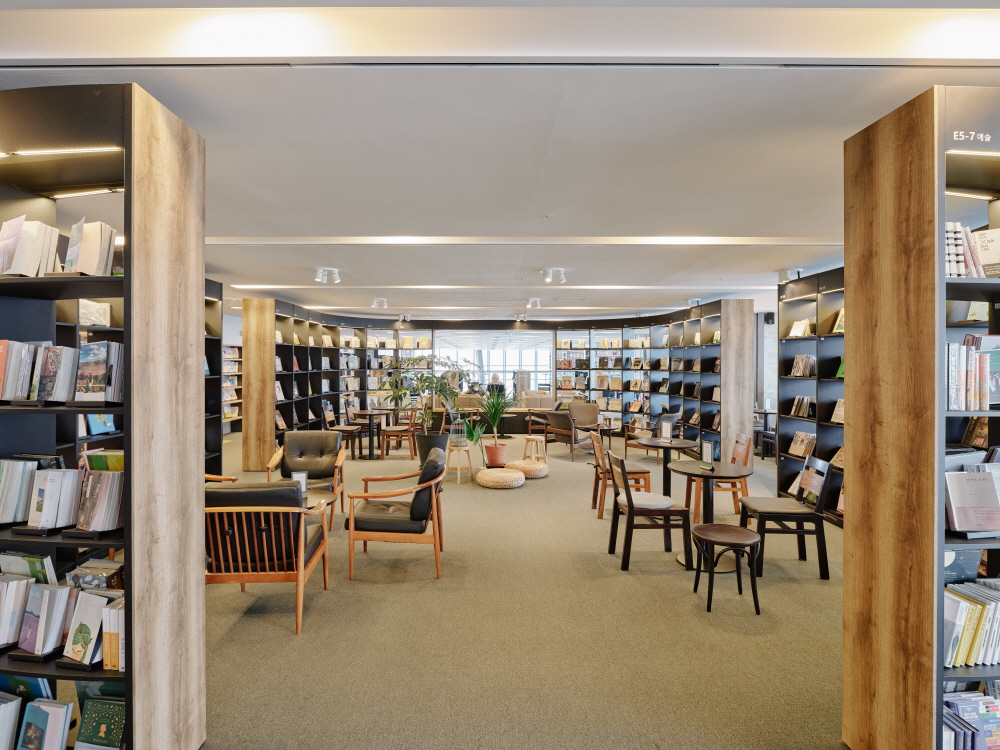 Café Comma Songdo
Café Comma Songdo
Kim: You designed two independent buildings by consulting architects in 2020 (Café Comma Yeonnam, covered in SPACE No. 658) and 2021(Café Comma Hapjeong). In increasing the number of branches, what were your intentions for the two buildings in the area in which Café Comma began its journey?
Yeom: Branches as part of a building are important. However I thought it was necessary to have a place that would serve as a central axis when considering the growth of the brand from a long-run perspective. We consulted architects, having already experienced the importance of architectural space through previous experiences, including Munhakdongne Publishing Group. Café Comma Yeonnam, designed by architect Kim Seonghoy, has a large open space on the first and second floors so that the scent of baked bread and brewing coffee permeates the space. The third and fourth floors were planned to offer independent working spaces. The basement area is encircled by books, radiating the feeling of being in a cosy library. In addition, considering the fact that it is located in a residential area rather than a commercial district, the exterior reveals a subtle personality without being too prominent. On the other hand, Café Comma Hapjeong, designed by Hyunjoon Yoo, is our R&D centre and consists of cafés with bookshelves on the two basement levels, a coffee lab on the third floor, an open space for working on the fifth floor, and an outdoor terrace space on the sixth floor. It is a six-storey building, the scale being larger and taller than existing Café Comma branches. It actualises the aims of establishing a book café as a landmark in Mangwon- dong. The building itself is designed in a shape of a book.
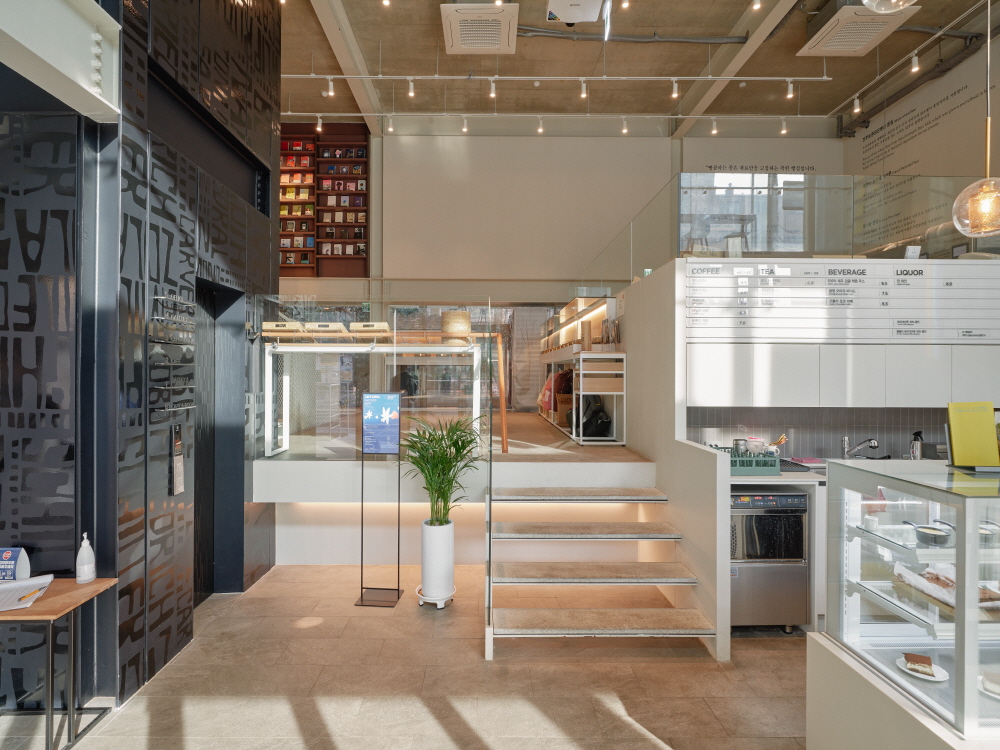
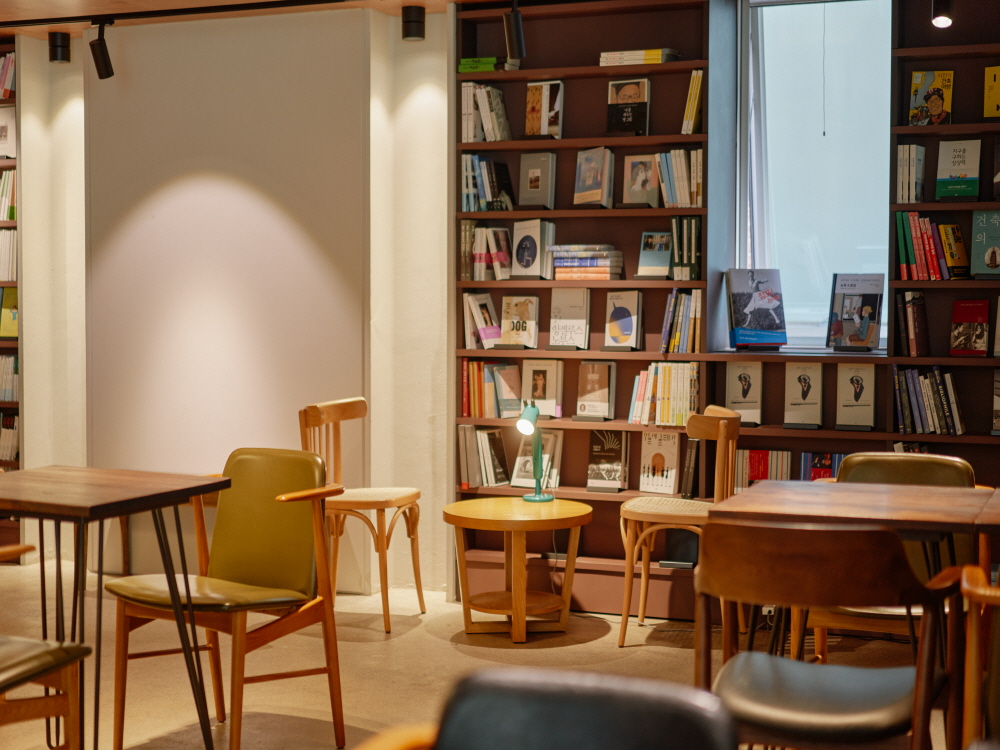
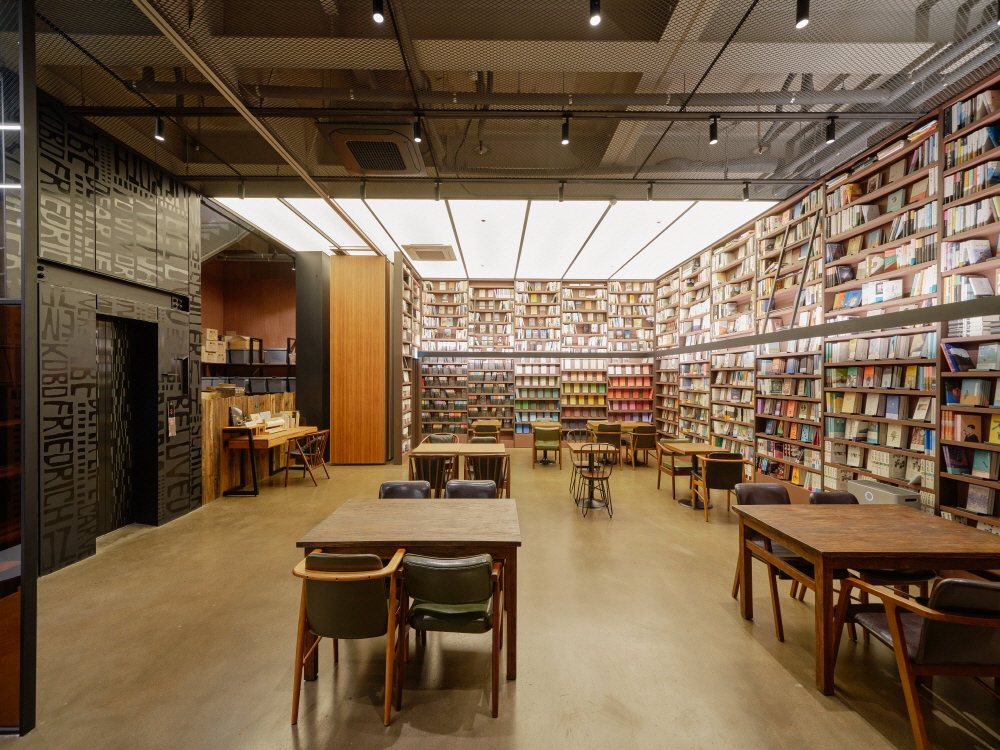 Café Comma Yeonnam
Café Comma Yeonnam
Kim: An increasing number of branches are located within buildings. Is there a set criteria for store locations?
Yeom: Currently, there are six road shops and five stores located within department stores. Initially, the height of the floor and spatial sensations were utmost in our minds. However, experience has led me to believe that locations are equally important. Unlike other cafés, Café Comma possesses the identity of a book café and therefore the contexts should resonate well with this identity.
Kim: An increasing number of branches are located within buildings. Is there a set criteria for store locations? Yeom: Currently, there are six road shops and five stores located within department stores. Initially, the height of the floor and spatial sensations were utmost in our minds. However, experience has led me to believe that locations are equally important. Unlike other cafés, Café Comma possesses the identity of a book café and therefore the contexts should resonate well with this identity.
Yeom: The area where Yeonnam branch, Hapjeong branch, and Donggyo branch are located has a lot of young people and a huge population flow. Some stay for a long time for the purpose of reading or working, while others visit for a short period of time. We tried to incorporate both needs in our design, separating the programmes by floor. In the case of small areas we employed furniture to enforce this separation. For example, in the basement of the Hapjeong branch, a sofa for one person and an individual stand have been placed to evoke an atmosphere conducive to reading, while on the second floor a shared desk for six people was placed to create a comfortable place for working on a laptop. In the case of stores within department stores, it is difficult to predict the surrounding context and therefore there are restrictions to the design possibilities. However, we find it meaningful to provide an area in which people can relax with books in a place where consumption and visual stimulation are dominating factors.
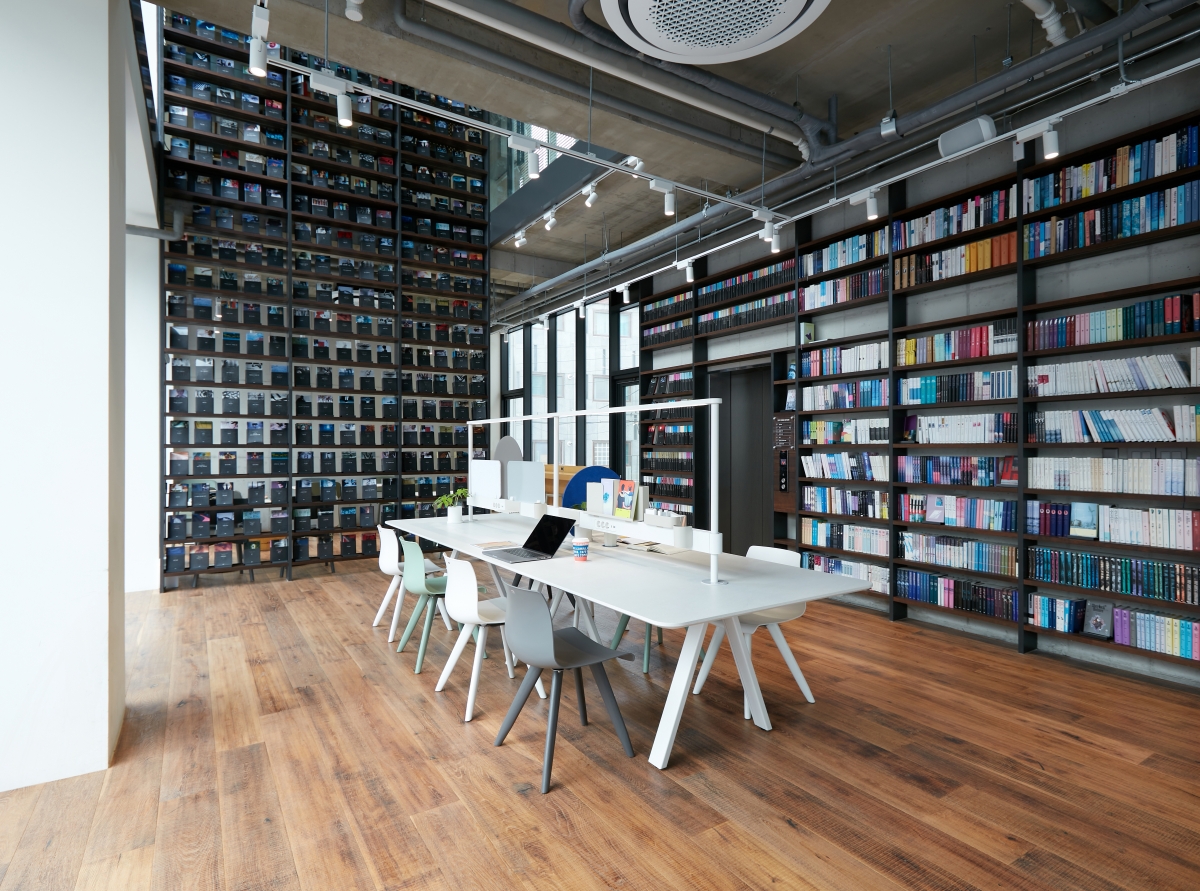
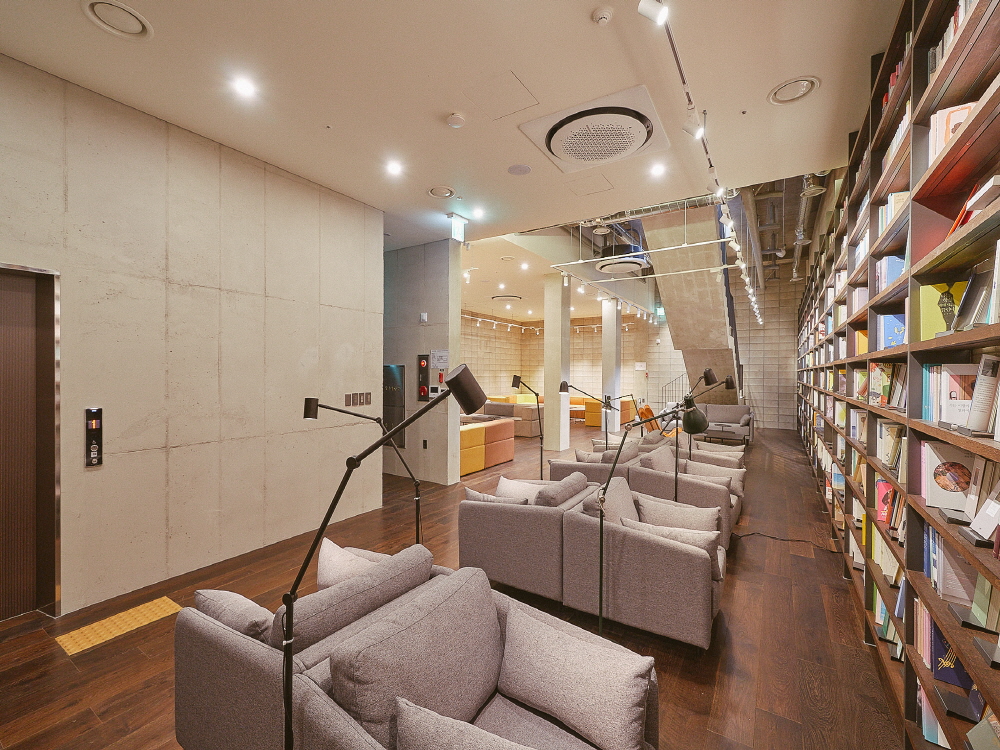
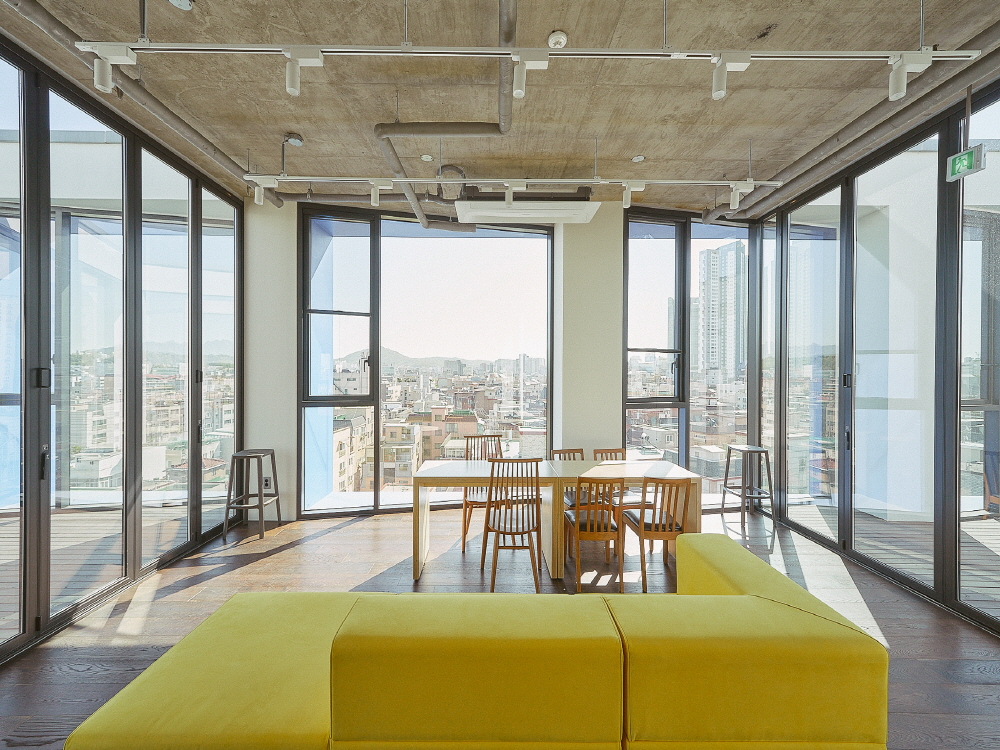 Café Comma Hapjeong
Café Comma Hapjeong
Kim: Not only spatial design, but also the experiences in F&B and the content that Café Comma provides seem to differentiate Café Comma from other cafés.
Yeom: I believe that the essence of a café lies in a series of activities such as meeting people, drinking coffee, and eating sweet treats. In this respect, we invested in developing coffee and bread culture after founding Café Comma. As Café Comma is a book café and not a library or a bookstore, we cannot limit our focus to books. However, books are still at the centre of Café Comma. Rather than just placing books on the bookshelves, we try to introduce good books regardless of publishers, through curation such as ‘New Books of the Month’ or ‘Library of Celebrities’. As an extension of such practices, we also organised book clubs and cultural events. For example, we held an event where people joined after reading bossa nova related novels and listened to bossa nova music while enjoying tropical fruit and coffee brewed with beans from South America.
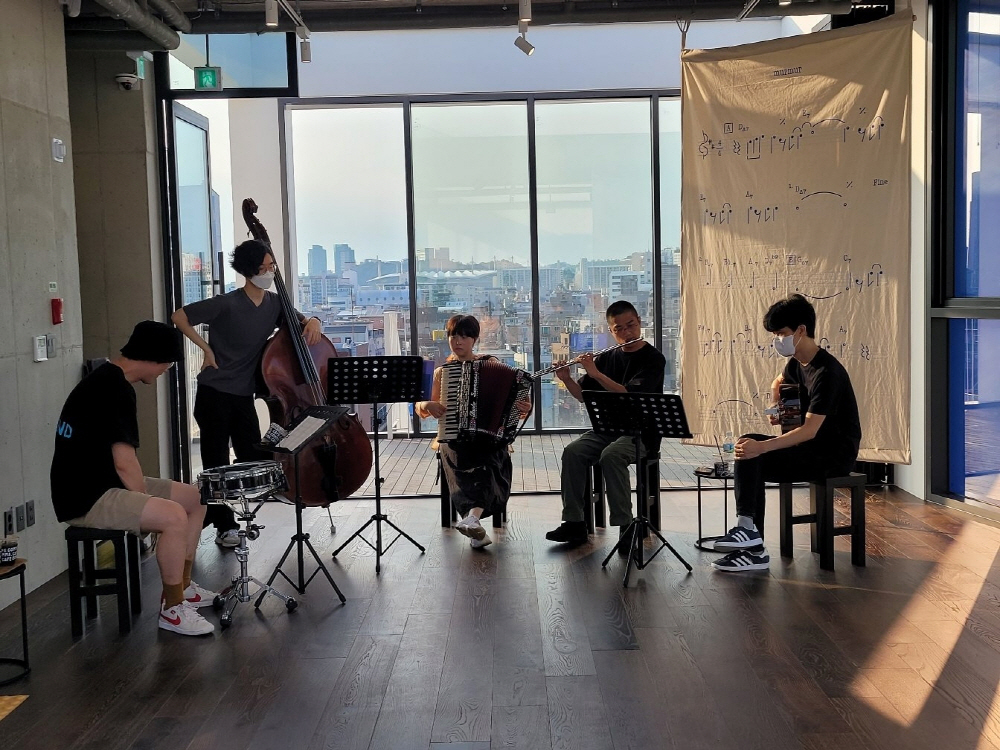 South American travel-themed event held at Café Comma Hapjeong
South American travel-themed event held at Café Comma Hapjeong
Kim: What are your views on the future roles and directions of Café Comma?
Yeom: Cafés in Korean society are continuously evolving. It is now more than a place for people to meet, and has become a place for rest and work. Café Comma intends to take the concept one step further and to serve as a place in which to enjoy and produce culture. The cultural act of experiencing something is not limited to extraordinary places. We intend to establish Café Comma as a daily space that inspires rest, in the here and now.
You can see more information on the SPACE No. 666 (May 2023).






